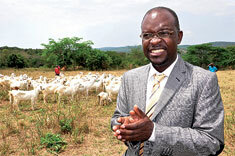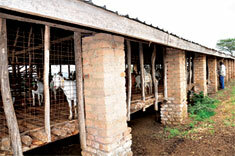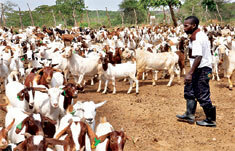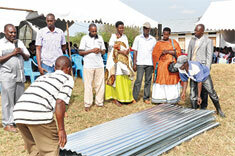Goatkeeping: Ssembeguya''s success has inspired his community
A visit to Paul Ssembeguya’s farm in Sembabule district best proves why he is well-known in the area. Ssembeguya rears over 2,500 goats and 1,800 exotic cattle on his farm.
By Ronald Kalyango
A visit to Paul Ssembeguya’s farm in Sembabule district best proves why he is well-known in the area. Ssembeguya rears over 2,500 goats and 1,800 exotic cattle on his farm.
He has distributed thousands of goats to farmers across the Masaka sub-region and hopes to give out at least 54,000 more in the coming few years.
Ssembeguya’s love for livestock dates far back to the ‘90s, when he returned from Britain. He had lived in Britain since he completed his Senior Six.
How he started
A self-taught goat breeding specialist, Ssembeguya got the idea of investing in livestock from his uncle, Edward Mugalu, whom he lived with in Britain.
Like most nkuba kyeyos (people working abroad), he saved money and bought three square miles of land at sh14m. He later acquired more land. Today, his farm sits on six square miles of land.
“By that time, I had done a lot of research on livestock and I was confident that investing in the sector was a lucrative venture,” he narrated.
Ssembeguya says he started with only 50 local goats and 70 head of local cattle.
He later crossbred his goats with pure Savannah and Boar goats from South Africa and eventually got better breeds.
Basing on his success, the National Agricultural Advisory Services (NAADS) programme partnered with him in 2006 to provide improved goats to farmers in the district.
 The first phase of the partnership kicked off with the NAADS secretariat supporting the programme with over sh200m. Ssembeguya provided 410 goats and 15 shelters to 15 groups in Lwemiyaga, Mijwala and Sembabule town councils.
The first phase of the partnership kicked off with the NAADS secretariat supporting the programme with over sh200m. Ssembeguya provided 410 goats and 15 shelters to 15 groups in Lwemiyaga, Mijwala and Sembabule town councils.
The second phase was implemented in the 2008/9 financial year and it also cost sh200m. Ssembeguya provided 312 goats and 12 shelters to another 12 groups in Ntuusi, Lwemiyaga and Lugusulu sub-counties.
Multi-billion project
Ssembeguya was again, in 2009, identified to run a five-year multi-billion goat breeding project in Sembabule district.
Under the sh6.4b project running until 2013, Ssembeguya was tasked to distribute 54,000 local goats to 108 farmers in Sembabule district. He gave an additional 350 pure Savannah goats as his contribution at a cost of sh700m.
“We want to raise quite a good number of White Savannah goats because our target market is the Arab world,” says Ssembeguya, the proprietor of Ssembeguya Estates.
With the funding from the Government, he has managed to distribute 17,220 female local goats and 108 Savannah goats to all the beneficiary farmers.
A total of 4,515 offspring have so far been registered with 1,443 as pure white breed, while 2,293 offspring represent other breeds. A total of 779 offspring have so far been sold off to other beneficiaries.
“This is a good trend and I think I have achieved my overall dream of creating more ‘Ssembeguyas’ in the district as directed by President Yoweri Museveni,” he explained.
“I think the best thing in life is being a poor man among 1,000 rich people instead of being the only rich among 1,000 poor people,” he adds.
Ssembeguya explains that before goats are distributed, they are branded, treated, sprayed, de-wormed and vaccinated against peste des petits ruminants, a highly contagious disease among the goats.
To acknowledge receipt of the goats, delivery agreements are signed between the two parties.
Ssembeguya says, for a farmer to benefit from the scheme, they have to have enough grazing land and basic knowledge about goat rearing.
“Once we assess and find out that a farmer has the above requirements, we proceed to support the farmer with the goats,” he notes.
Cooperative society
For easy marketing of their goats, farmers in the area have registered a cooperative society – Sembabule Goat Breeders and exporters Cooperative Society. The best farmers under the project are also to be rewarded annually. This year, the best five farmers received 20 iron sheets each.
Next year, two farmers will be rewarded with two motorcycles and in the final year, a new pickup truck will be given out to the overall best farmer.
Achievements
Ssembeguya is quick to call the project and as a great success.
“I am also a progressive commercial farmer with undying desire to develop animal husbandry,” he says.
Ssembeguya attributes his success to working with people and employing veterinary doctors, who keep his livestock healthy.
“It is important for one in business to avoid being an island. Employ technical people, tell them what you want and treat them like human beings. They are not doing you a favour neither do you do them a favour by employing them,” he advises.
In 2006, Ssembeguya Estates Uganda Limited was nominated by the Uganda Investment Authority as the investor of the year (diaspora category).
Owing to the success of this business, President Museveni paid Ssembeguya a visit at his farm in Ssembabule district.
“I didn’t know he was in search of goats to export to the Arab world. He fell in love with what he saw as he toured my farm,” notes Ssembeguya. “Apparently, the President’s advisors had told him that it was impossible to rear Savanna goats in Uganda. But I was a living testimony in the district.”
Challenges
The district veterinary officer, Dr. Angello Ssali, however, noted that despite the different interventions, the enterprise is still constrained by rampant goat diseases like helminthiasis, brucellosis, heart water, kid diarrhoea and of late, dermatomycosis.
“There is also indiscriminate breeding, high theft rates of goats and inadequate water resources,” he explained.
On his part, the acting director of animal resources, Dr. Nicholas Kauta, who handed over 100 iron sheets to the best successful farmers, cautioned them against unnecessary movements of goats to avoid the deadly goat plague disease.
Kauta noted that the Government had so far imported two million doses of vaccines to treat the rampant goat plague, now ravaging livestock animals in the Karamoja sub-region.
He appreciated Ssembeguya’s efforts towards the development of the livestock sector and assured him of the government’s support.
“This project will help in the establishing of nucleus breeders, outgrowers and stratify the breeders as we as link them to strategic local and regional markets,” said Kauta.
 Advice
Advice
Ssembeguya says goat production is the second most important economic enterprise only next to cattle, especially in the rangeland areas in the district.
Goats also play a vital social-economic and cultural role in the livelihoods of the rural communities by providing mainly meat and income.
The district also has a great comparative advantage for goat production because it is located in the south western dry savanna with plenty of shrubs, mainly accassia that is very suitable for goat production.